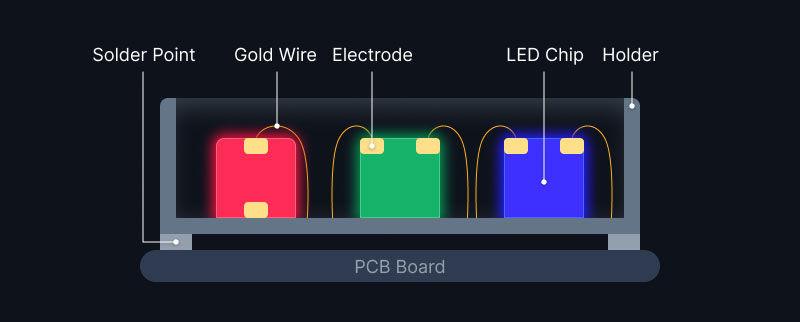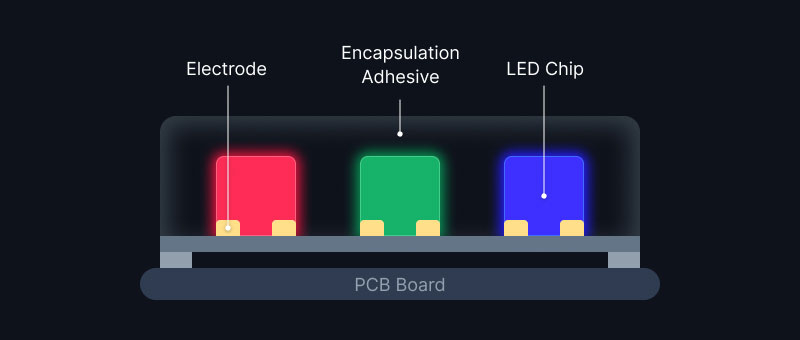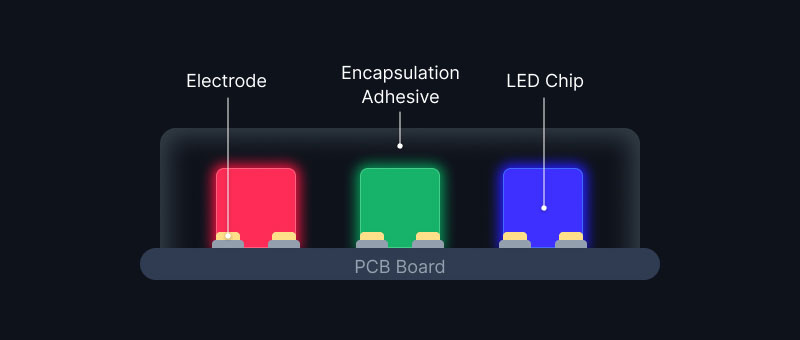SMD, MIP, and COB: The Three Main LED Packaging Technologies You Should Know
In the LED display industry, packaging technology determines display performance, durability, and application range. Today, SMD (Surface Mounted Device), MIP (Mini LED in Package), and COB (Chip-on-Board) are the three most common technologies. Each has its strengths and ideal application scenarios. This article will help you understand their differences and choose the best option for your project.
1. SMD (Surface Mounted Device)
Technology
SMD LEDs are made by packaging red, green, and blue chips into a single LED unit, which is then mounted directly onto the PCB surface.
Advantages
-
Mature technology with lower manufacturing costs
-
Wide pixel pitch range, from P1.25 for indoor to P10 for outdoor
-
Easy maintenance—individual LED modules can be replaced
Limitations
-
Exposed surface makes it more vulnerable to impact or damage
-
Higher precision required for small pixel pitch
Best Applications
Outdoor billboards, rental stage screens, indoor conference displays, and other medium-to-large pixel pitch projects.

2. MIP (Mini LED in Package)
Technology
MIP bridges the gap between SMD and COB. Mini LED chips are packaged individually before being mounted onto the PCB, offering improved performance without fully integrating into the board like COB.
Advantages
-
Supports smaller pixel pitches (P0.x level)
-
Higher production yield compared to COB
-
Stable brightness and color uniformity
-
Easy to replace individual LEDs
Limitations
-
Higher cost than SMD
-
Technology still evolving
Best Applications
Premium indoor displays, broadcast studios, control rooms, and fine-pitch commercial screens.

3. COB (Chip-on-Board)
Technology
COB involves mounting bare LED chips directly onto the PCB and covering them with a protective layer, eliminating the traditional LED lamp package.
Advantages
-
Flat, seamless surface for better protection against dust, moisture, and impact
-
Ultra-high density, supporting pixel pitches as small as P0.4
-
Superior heat dissipation and extended lifespan
-
Higher durability for public environments
Limitations
-
More expensive to produce
-
Repair requires replacing the entire module
Best Applications
High-end control rooms, security monitoring centers, banking institutions, and flagship retail displays.

4. Quick Comparison Table
| Feature | SMD | MIP | COB |
|---|---|---|---|
| Cost | Low | Medium | High |
| Protection | Medium | Medium-High | High |
| Maintenance | Easy | Easy | Difficult |
| Pixel Pitch Range | ≥P1.25 | ≥P0.7 | ≥P0.4 |
| Brightness | High | High | Medium-High |
| Applications | Indoor + Outdoor | Indoor High-End | Indoor Ultra High-End |
5. Market Trends
-
SMD will remain dominant in outdoor and large pixel pitch markets.
-
MIP is likely to become the preferred choice for small pixel pitch commercial displays.
-
COB will grow rapidly in ultra-fine pitch and high-protection displays.
As Mini LED and Micro LED technology continues to advance, we can expect higher resolution, lower power consumption, and improved durability across all display types. Choosing the right packaging technology will help balance cost, performance, and maintenance needs for your project.
Why Choose CNLC?
As a professional LED display manufacturer, CNLC offers SMD, MIP, and COB solutions for indoor and outdoor applications, from commercial advertising to control room installations. Whether you provide your own LED screen or require a complete turnkey solution, we can deliver custom manufacturing, integration, and after-sales support to ensure your project stands out in the market.